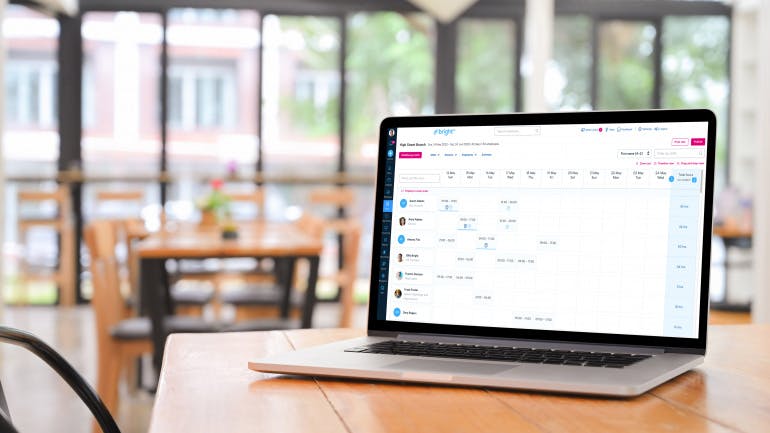First published on Thursday, June 4, 2020
Last updated on Tuesday, June 18, 2024
A human resource information system (HRIS) or HRIS software is a digital solution, platform, or database with tools to help small or large businesses manage staff-related issues, handle employee data more easily, and automate key employment tasks.
Having a solid HRIS management system can bring lots of benefits to your business and help you overcome some of your trickier staffing challenges.
This article will take you through the main features, types, and benefits of having HRIS software.
So, let’s dive in at the beginning…
What is HRIS?
HRIS stands for Human Resources Information System. The exact meaning of HRIS is a software or system that helps businesses manage and process employee information with human resources (HR) related policies and procedures.
A human resources information system lets your business establish a central resource for employee data to keep information like:
Employee names and contact details
Medical information
Payroll information to report to HMRC
Absence records
Contract and annual leave information
Role information
Overtime and TOIL data
Emergency contact information
Important employee documentation
Essentially HRIS applications collect all the personal data you need to employ people and keeps everything in a safe GDPR-compliant place.
How do businesses use HRIS systems?
Many businesses use Human Resources Information Systems in the form of HR software to manage their day-to-day people admin. For example, keeping on top of staff holiday management, tracking absences, time & attendance, and recording sick leave and lateness.
HRIS systems often have additional functionality for other areas of business like payroll, employee benefits, reporting, and performance management. But as these features vary depending on the type of HRIS software you choose, let’s cover some examples of the different types of human resources information systems available to you.
Examples of HRIS features
The best HRIS combines features that help streamline all aspects of your human resource management. For example, BrightHR software has HRIS features that include both data and information storage as well as HRMS functionality for all areas of employee management.
Some BrightHR HRIS features include:
Staff holiday planning software: Enables easier management of your workforce’s annual leave requirements
Shifts & rota planning software: Helps you create your work schedules and plan employee rotas
Cloud-based HR document storage: Safely stores your HR policies and data online with unlimited storage
An employee time-keeping app: Allows you to track and record employee hours so employees can clock in for their shift in a click
Absence software: Manages employee absences like sick leave, lateness, doctors’ appointments and more
Overtime tracking: Helps you record any extra hours your staff do and send data straight to payroll
Expense tracking: Allows you to track employee spending and maximise your tax savings
Recruitment software: Streamlines the hiring and onboarding process with software, documents, and support
Employee recognition platform: Helps you celebrate team achievements with an employee praise platform
Payroll software: Simplifies the payroll process with end-to-end software and support built into your HR system for convenience
Redundancy tool: Provides step-by-step redundancy advice and software to manage the process
What are the main benefits of having an HRIS management system?
Having an HRIS management system has many benefits for your business and we've looked at HRIS benefits in more detail. And the right HRIS solution can even help you overcome some of your biggest HR challenges.
Some benefits of using an HRIS include:
More time to focus on your business: HR software speeds up your everyday admin and can save you valuable time
Better visibility and trend tracking: With HRIS software you can record everything from absence to lateness and staff hours allowing you to manage your people more effectively
Reduce costs: Having the right HRIS solution will help you minimise costs like HR documentation services and minimise hiring and turnover cost
There are many more benefits to wrap your head around and it’s important to do thorough research on how digital software can improve your business’ HR productivity before you commit to a provider.
Now you know the features and benefits of having an HRIS management system, the last piece of the puzzle is implementation.
How to implement HRIS in your organisation
So, you’ve chosen an HR provider—great! Now, implementation is the next step.
Here are 4 steps to HRIS implementation:
Identify your requirements for example, are you moving providers, do you need to factor in data transfer or are you starting from scratch? Make sure these are clear before you start the implementation process.
Assign a point of contact or project manager to handle the process of implementing your HRIS solution, this will make it easier further down the road when your team have questions as they’ll have one single source of truth and contact.
Create a good employee training strategy fully training staff on your new HRIS system is key, make sure you choose a provider with easy to follow how-to-guides to make this process more seamless.
Organise dedicated in-person or virtual onboarding sessions with a third-party. This can help you get up and running quickly and answer any questions you may have before you role your HRIS solution out to your staff.
How BrightHR can help you find the best HRIS for your business
Wondering which piece of software will work for your business, or how it’ll make a difference to your daily routine?
Check out our guide to choosing HR software. It has all the information you need to know before making your decision.
Have a question?
Ask away, we’ve got lightning fast answers for UK business owners and employers powered by qualified experts.










